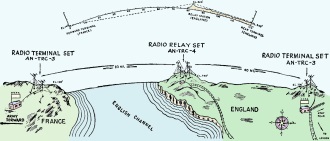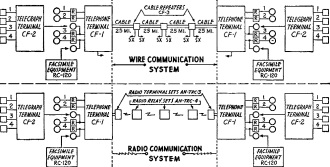Army Radio Communications
|
|
Seamless integration of wireless communications with wired communications has not always been a yawn in technical strategy discussions. It has really only been since the early 1990s with the introduction of ubiquitous cellphone systems that someone on a wireless device could connect directly with a wired (i.e., landline) contact and not need an intermediary operator to facilitate. Some military communications, the Inmarsat system, and a few other proprietary systems were available, but not to the public at large. This article reports on some of the Army's early attempts at implementing wireless-to-wired communications, specifically as implemented during the Normandy Invasion on D-Day. Unlike present day systems that rely heavily on data compression and massive multiplexing, those systems allocated the standard audio (voice) bandwidth to each channel. How many of us can remember how nice it used to be when we could carry on a telephone conversation and not suffer the annoyance of momentary dropouts and system delays that are sometimes so bad that it is almost necessary to go back to the old WWII radio era "over" declaration at the end of each sentence so the person on the other end would know it is OK to start talking? Army Radio CommunicationsHow the relay link sets were employed in the Normandy invasion. The central relay station is two terminal sets placed back-to-back. Although the Army's basic policy considers wire to be the primary means of communication, and radio the secondary means, the very nature of this war with its highly mobile forces deployed throughout the world has placed ever increasing emphasis upon radio as the primary means for communications with highly mobile elements such as aircraft, tanks, amphibious vehicles and assault troops, or across enemy held territory and over water and terrain inaccessible to wire line construction. Radio must provide a degree of service comparable to that of a wire facility, including when necessary, the capability of being tied in with existing wire circuits to form one system giving the same grade of service as the wire system. One of the outstanding developments of this war in Military Communications is the Army's VRF Radio Relay System which provides a true integration of wire and radio circuits into a single system or may be used as a separate system in much the same manner as the wire circuits. The heart of this system is the broad band FM radio set, designated AN/TRC-1 developed by the Camp Coles Signal Laboratory of the Signal Corps Ground Signal Agency with the collaboration of the Link Radio Corporation. This set is capable of operation either as a terminal of a radio circuit or as an automatic radio relay set between the two terminals of a radio circuit in extending the overall communication range beyond the distance range of an individual radio set. It is used in conjunction with the Army's telephone "spiral-four" carrier cable system which provides the practicable terminal equipment whereby a radio circuit can be integrated with the wire circuit, or substituted therefore, in whole or in part, as the necessity dictates. Fig. 1 shows a simplified functional diagram of a complete multichannel VHF radio relay communication system. The telephone and telegraph terminal equipment CF-1 and CF-2 is common to both the radio system and the "spiral-four" wire system. The radio terminal set is connected to its associated telephone terminal by "spiral-four" cable up to approximately 15 miles in length, one pair of the cable being used for transmitting and the other pair for receiving. The radio relay sets comprising in effect two radio terminal sets connected back-to-back are substituted for the telephone repeaters of a wire system. Duplex operation is achieved by the use of separate receiving and transmitting frequencies at each radio set. Fig. 1 - A typical army network, in which wire lines, carrier channels and VHF radio circuits are combined in a large multi-channel system. Four telephone channels, each approximately 2800 cycles wide, within an audio frequency band of 200 to 12,000 cycles are obtained from the Telephone Terminal CF-1. Channel 1, operating at voice frequencies, is normally used as an order channel for intercommunication between terminals and relay sets for supervision and line-up purposes within the system. Each radio set is equipped with filters to confine the order channel to the band 200 to 3000 cycles and prevent mutual interference with the carrier frequency channels. Ringing over the individual telephone channels is accomplished from field telephones or switchboards by the use of voice frequency ringers which provide a 1000-cycle tone modulated by the 20-cycle telephone ringer. Tone teletype channels may be provided over anyone telephone channel by the connection of the Telegraph Terminal CF-2 thereto. Additional teletype channels may be applied in like manner to other telephone channels. Facsimile service may be obtained by the use of Facsimile Equipment RC-120 on anyone or more of the telephone channels. The principal characteristics of the radio receiver and transmitter are: (1) a horizontal three-element antenna array comprising a driven dipole fed by a 50-ohm flexible solid dielectric coaxial transmission line and parasitically excited reflector and director dipoles, all adjustable in length to the operating frequency and supported on a mast head by a 40-foot sectional steel tube mast; (2) a 2500-watt, 115-volt, 60-cycle, gasoline engine driven generator. A 250-watt radio frequency amplifier is available as auxiliary equipment for use with the 50-watt radio transmitter to increase signal strength over unusually long or noisy transmission paths, where high power is advantageous. On the second day after the initial landing on the Normandy coast, the cross-channel circuit illustrated above began operation, providing initially facsimile transmission of air reconnaissance information on military objectives from a Tactical Air Command Headquarters to the invasion forces. Shortly thereafter full multichannel telephone and teletype facilities were provided from Central Headquarters in England to the field commanders of the First U. S. Army in France. Following these outstanding uses, other armies, as they became operational on the continent, extended similar multi-channel radio facilities to their Corps, from their Corps to Divisions and between Corps within each army. The Air Forces likewise linked their base command establishments by means of similar radio circuits providing the establishment of equivalent wire circuits. As the Armed Forces progressed across France additional radio relay facilities were established for both tactical requirements in the forward areas, and for administrative purposes in the rear Communication Zone. With the installation of additional cross-channel facilities, and of wire lines and other radio circuits on the continent, the radio relay systems became part of a completely integrated and comprehensive network of telephone, teletype and telegraph circuits covering an area in Europe equivalent in size to that from New York to Chicago and from Detroit to Atlanta. Through this integration, the radio systems became vital links in the network in providing primary circuits under enemy fire which took prohibitive toll of lives and material during attempted wire installations, or over terrain impassable to wire lines; and also emergency circuits in the event of traffic overloads or failures of other facilities. In citing the importance of this equipment as an emergency facility during a failure of the main cable system across France as a result of combat operations, the Chief Signal Officer, Major General W. Rumbough, European Theater of Operations, stated, "In spite of this very serious cable interruption, and I do not think any single trouble could have been worse, we handled 2709 messages -, that is nearly 2 messages per minute throughout the 24 hours." The logistical advantages accruing from the use of radio relay communication system over the "spiral-four" cable system, as illustrated in Fig. 2, have been the principal factors through which this type of equipment has achieved its favorable reception and praise in relieving transportation. installation and maintenance problems. Greatly expanded commercial use of the principles for post-war applications are indicated. Wire Communication System 1. Approximately 94 ship-tons of equipment required for a fixed system length of 100 miles. 2. Requires large force of men and materials for installation and maintenance. 2. Subject to interruption from enemy action, equipment failure, and electrical interference at an infinite number of points along cable route. 4. Not suitable for transmission over large bodies of water or territory controlled by the enemy. Radio Communication System 1. Approximately 25 ship-tons of equipment required for a system length of 100 miles in average terrain. Indicated number of radio relay sets may be reduced, or system length may be increased without additional equipment, when radio sets are installed on high elevations which afford long transmission paths (without greatly exceeding line-of-sight) between stations. 2. Installed, operated and maintained by a small force of men without special equipment or materials. 3. Subject to interruption from enemy action, equipment failure and radio interference at 5 points only. 4. Well adopted for transmission over reasonably large bodies of water or portions of territory controlled by the enemy.
Posted May 19, 2023 |
|



